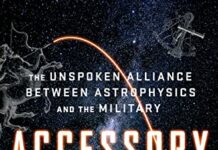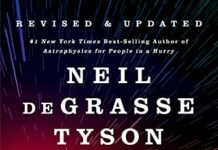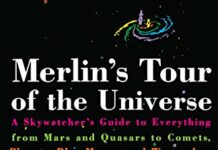
Ebook Info
- Published: 2007
- Number of pages: 385 pages
- Format: PDF
- File Size: 1.74 MB
- Authors: Neil deGrasse Tyson
Description
[Tyson] tackles a great range of subjects…with great humor, humility, and—most important—humanity. —Entertainment WeeklyLoyal readers of the monthly “Universe” essays in Natural History magazine have long recognized Neil deGrasse Tyson’s talent for guiding them through the mysteries of the cosmos with clarity and enthusiasm. Bringing together more than forty of Tyson’s favorite essays, Death by Black Hole explores a myriad of cosmic topics, from what it would be like to be inside a black hole to the movie industry’s feeble efforts to get its night skies right. One of America’s best-known astrophysicists, Tyson is a natural teacher who simplifies the complexities of astrophysics while sharing his infectious fascination for our universe.
User’s Reviews
Reviews from Amazon users which were colected at the time this book was published on the website:
⭐The title of my review is an anagram for a Latin phrase that translates to “I have observed the most distant planet to have a triple form.” Written by Galileo in 1610, its intended purpose was to establish priority for his discovery of Saturn’s rings, while continuing his exploration of the planet until he was ready to make a formal announcement. This is just one of the hundreds of interesting facts scattered throughout “Death by Black Hole,” a collection of 42 essays by Astrophysicist Neil deGrasse Tyson, originally published over a twelve year period in Natural History Magazine.”Death by Black Hole” is part of the emerging trend of hard science books written by accredited scientists, which seek to convey complex subject matter to the average reader. You don’t see too many of these books because the people who would be needed to write them are usually too busy writing papers with subjects like “Non-LTE Plasma Diffusion in Inhomogeneous Atmospheres.” Those gifted with such knowledge mostly write for their peers. Even books written with a mass audience in mind, such as those by Stephen Hawking and Carl Sagan, can be difficult for the lay person to understand. Fortunately, the cosmos has gifted our tiny ocean planet with Tyson, who is quickly becoming the “Mr. Wizard” for a new generation. Although this book is a selection of previously-printed essays, it is edited together to form cohesive ideas about the nature of our universe. The seven sections of the book are divided as follows:1. The Nature of Knowledge – How are scientists able to presume that the Big Bang occurred 13.7 billion years ago? How can we study the elemental components of a star that has long since died? Tyson looks at the physicality of laws and how science is exploring beyond our five senses. This section gives a good primer on many of the most basic questions those new to cosmology might have, and how our knowledge has expanded throughout history.2. The Knowledge of Nature – This section is probably the most “scientific” of the book and goes a lot more into the nature of elements. It definitely helps to have a very basic understanding of atoms, matter, electrons, and photons. If you don’t, Tyson still explains things fairly well, but you may have to read it a couple times. The next chapters discuss the exploration history of the planets and smaller non-planetary objects (I’m looking at you Pluto), quantum theory, and special relativity.3. Ways and Means of Nature – Do you like pie? Of course you do, who doesn’t? Do you also like pi? If so, chapter eleven is for you as Tyson looks at what makes this constant and others so interesting. And if there’s one thing that’s important to astrophysics, it’s constants. An entire chapter is devoted to the most famous constant of all – the speed of light in a vacuum. Several other chapters are devoted to the important that density and mass have on objects in the universe, star light, radio waves, color, plasma, and heat.4. The Meaning of Life – A look at how humans developed from all of this cosmic material, and explanation of how all of us are made of star dust. If any of this section is lost on you I encourage you to give it another read, as it’s one of the most fascinating in the book when you take it all in. The possibility of life (intelligent or not) in the universe is also expounded on5. When the Universe Turns Bad – Another fascinating chapter that discusses all the ways the universe “plans to kill us.” Whether our sun runs out of hydrogen and envelopes us in a fiery death, or we are hit by an asteroid before we have time to send Bruce Willis into space to blow it up, it is clear that eventually our planet will cease to exist.6. Science and Culture – How society reacts to cosmic discovery and how that reaction has changed over time. Tyson makes the following statement that I think sums up this section nicely and leads into section 7: “when people believe a tale that conflicts with self-checkable evidence it tells me that people undervalue the role of evidence in formulating an internal belief system.” Tyson discusses several examples of this including why our society insists on removing the number 13 from buildings, exclaiming that Polaris (the North Star) is the brightest star in the sky, and why we keep portraying the sun as yellow when it is actually white.7. Science and God – The presumed disconnect between science and religion, and how some scientists are able to allow their religious faith to coexist with the empirical evidence they know about the universe. As a subject I have often struggled with, I found this to be a very interesting section for Tyson to include, and a great way to end his book. He provides some interesting insight into religion without outright dismissing it as other scientific books have done, and even describes his own views on it (although you have to look for them).Given that it is a collection of self-contained essays, it can seem like some of the chapters don’t flow as nicely into each other and seem a little disjointed. However I think the editing does a great job of covering that up and I didn’t notice it too much while reading. Some readers may find a few of the chapters a bit too “sciency” for them and hard to grasp, but overall I think the book works very well for the reader who has an interest in the world around them and wants to know more. Neil deGrasse Tyson is probably the foremost expert for bringing difficult material to a general audience and “Death by Black Hole” is no exception. If you’re still undecided about purchasing the book, you can read the first 134 pages of it at Publisher WR Norton’s web site. Do a search for it by name, the click the “Inside the Book” link from the product page.
⭐Neil deGrasse Tyson is an astrophysicist with the American Museum of Natural History, where he serves at its world-famous Hayden Planetarium. Readers of Natural History magazine will be familiar with the topics covered in this book. Each of the book’s 42 chapters first appeared, in one form or another, on the pages of Natural History magazine under the heading “Universe” and span the 11-year period of 1995 through 2005.This is a great book to learn about our universe. I love the author’s sense of humor. It was hilarious when he told James Cameron that he had the night sky all wrong in his movie Titanic. To this, Cameron replied, “The film, worldwide, has grossed over a billion dollars. Imagine how much more money it would have made had I gotten the night sky correct!” The author mentions other Hollywood goofs concerning our universe, like Disney’s Black Hole.Tyson takes readers on an exciting journey through space. Tyson shows how what we once believed isn’t necessarily true. For example, scientists once believed that it would be impossible to go faster than the speed of sound; we would never be able to reach space; we would never walk on the moon etc… Now we say that we could never go faster than the speed of light. Will we one day? Interesting thought. What we think off as impossible is actually not impossible.Today we know that life can survive in impossible environments. For example, in volcanoes, in Antarctica etc. So too life could survive in space.The color of the universe is gray. What color is the sun? White? Yellow? Orange? Read the book. “If the sun were yellow, like a yellow light bulb, then white stuff such as snow would reflect this light and appear yellow.”Are there Canals on Mars built by intelligent beings? Some theories speculate that in order to survive global warming, Martians built canals from the North Pole where the icecaps are, to the much needed interior where water was scarce. Tyson explains how one could come up with such an erroneous assumption.It is believed that Europa might have water under its surface where life could abound. After all, water was brought to our planet by asteroids and comets.Drake’s equation shows that there must be life elsewhere. We once believed that earth was the center of the universe. Now we know it is not. Why should we think we are the only intelligent beings in the universe? There are many galaxies with planets revolving around their suns. We are not unique.The moon has a unique place in our galaxy. There are those who want to project strong laser-like light on its surface to carry advertisement on its surface. Imagine looking up at the night sky on the moon only to see a Pepsi ad projected on its surface. Others want to get rid of it by blowing it up. “It’s the only way to rid the world of scorching deserts and arctic winters,” says Professor Alexander Abian, a mathematician at the University of Iowa. He claims that by getting rid of the moon, the Earth will then be able to shift into a “more desirable orbit.” Abian suggests strategically placed hydrogen bombs on the moon can either blow it apart, or send it careening into outer space. The change would make our weather less extreme, turn our deserts into fertile farm land, and make the north and south Polar Regions livable.On a more scientific and acceptable proposition, NASA wants to build its telescope on the moon because, you guessed it, the moon has no light pollution.Did you know that it would only take a few hours for a broadcast from Earth to reach Saturn? One day we may very well communicate with other civilizations scattered around our universe.Tyson explains all the ways the cosmos wants to kill us, and had been doing so for millions of years. For example, scientists know that in a few billion years, an expanding sun will vaporize the earth, provided it’s not been previously destroyed by a rogue black hole or a comet.If there was a Big Bang, where did the elements come from? And if the universe is expanding but finite, into what is it expanding? Another universe?What goes up does not necessarily have to come back down. Take the golf balls on the surface of the moon. They went up with Armstrong and never came back down.The sun does not rise from the east and set in the west. Sometimes in goes in a straight line and sometimes it never sets or rises. Don’t believe me? Spend your summer in the North or South Pole.How come total solar eclipses seem rare, but actually happen every couple of years?Did you know there is an asteroid that in 2029 will come so close to Earth that it will pass underneath some of our satellites and if its path travels through certain spot or “keyhole” by Earth, its orbit will fluctuate enough to send it on a collision course with Earth in 2037?This is really a fun book. I found myself laughing out loud and smiling at many passages, as well as being astonished at the many revelations the author makes. This book will make you think just how small and insignificant we are in the universe. It will also make you wonder what is beyond the universe. I always wanted to be Captain Kirk and go explore the universe.Many concepts in this book aren’t simple, and prior knowledge of the universe is required to fully understand this book. And one more thing: This book is not about black holes.Tyson reflects: “What are the lessons to be learned from this journey of the mind? That humans are emotionally fragile, perennially gullible, hopelessly ignorant masters of an insignificantly small speck in the cosmos. Have a nice day.”
⭐Dear Neil,Once and for all, Galileo was not prosecuted for having reaffirmed the Copernican thesis, but for asserting that this was in perfect accordance with the sacred texts. That is to say, he crossed the line of his strict competence. If he had kept his theory in the purely scientific field, I have no doubt that the Church would have quickly incorporated his advances and there would have been no uproar. Just for the sake of argument, Pope Urban VIII was a close friend of his and, in fact, allowed him to spend his imprisonment in a friend’s castle rather than in jail. Galileo died in peace and friendship with the Church, being the good Christian that he was.Another thing to consider is the context in which the controversial case occurred: the midst of the Protestant Reformation, when many turned away from the doctrine of the Church and began to misrepresent the teachings of Christ in a complementary way. Obviously, the Church had to be forced to correct these errors: it is what any person or institution would do when it is unjustly defamed, and its teachings are sought to be corrupted. Incidentally, the harshest critics of Galileo and Copernicus were Martin Luther and Melanchthon, not the Catholic Church.Finally, if all of the above were not enough, Pope John Paul II publicly apologised for the case and acknowledged that the Church perhaps could have done better and could have treated him even better. But in no case did he refuse to accept the scientific advances of the time and even less so today, as long as they do not threaten the dignity of the human being, moral good and evil.
⭐I am reading loads of books, and I have loads more to read, waiting down the pipe. But this is probably one of few I will read again. That was such a good, nicely, smooth written science, I love how Neil is so vividly describing ie conditions inside core of our Sun or how atoms interact. He is literally pushing my imagination to the limits. Must have read book for everyone who enjoys astronomy !!!Now, I need to buy printed version to proudly put it on my shelf.
⭐This was enjoyable.
⭐Like all his books I’ve read, superb.
⭐Dad loved it – great Christmas present. Neil DeGrasse Tyson has a great narrative skill in explaining these concepts to people who haven’t studied them formally.
⭐Excellent for use and does its job well. Packaging was great and came quickly.
Keywords
Free Download Death by Black Hole: And Other Cosmic Quandaries in PDF format
Death by Black Hole: And Other Cosmic Quandaries PDF Free Download
Download Death by Black Hole: And Other Cosmic Quandaries 2007 PDF Free
Death by Black Hole: And Other Cosmic Quandaries 2007 PDF Free Download
Download Death by Black Hole: And Other Cosmic Quandaries PDF
Free Download Ebook Death by Black Hole: And Other Cosmic Quandaries


